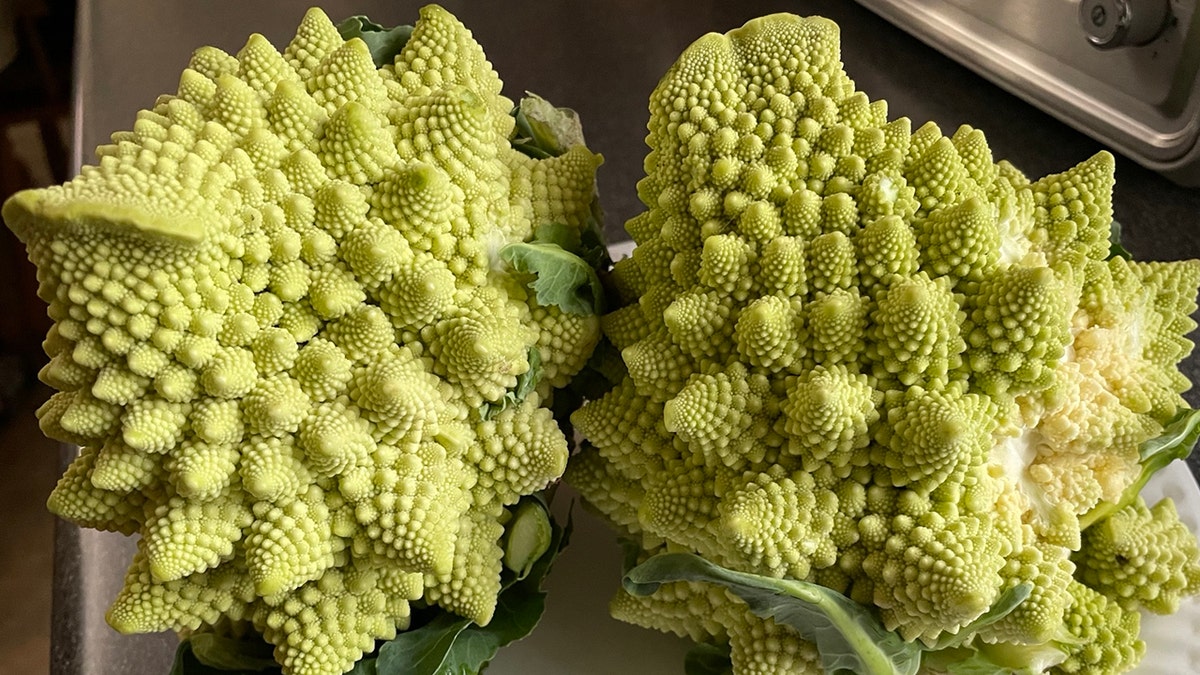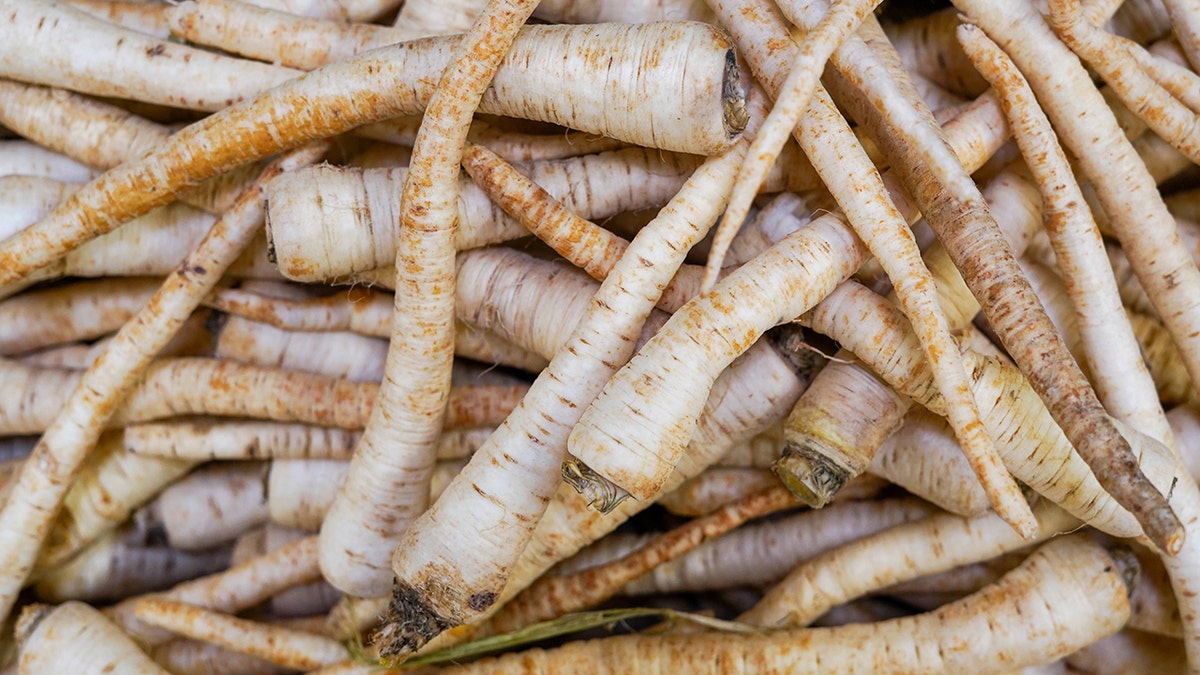If you're in a veggie rut and tired of green beans, peas, and carrots, it might be a good time to try some unusual but healthy veggie selections this season.
They can energize your dinner repertoire, enhance your salad routine, and add color and texture to your soups and stews this season.
Three registered dietitians shared their secret winter vegetable picks with Fox News Digital so you can have a heartier veggie game plan.
THE BEST VEGETABLES FOR YOUR HEALTH, ACCORDING TO NUTRITIONISTS
Check out these delicious food deals and keep your eyes peeled the next time you head to the grocery store or farmers market.
swedish turnip
Sweeter than its turnip cousin, this root vegetable has a creamier consistency when cooked, said Julie Lopez, RD, owner of New Jersey-based Virtual Teaching Kitchen.
Try some fun, unusual and healthy vegetables this season. From left to right: Kabocha squash, celery root and romanesco. (iStock/Fox News Digital)
“In their raw state, rutabagas also have a more yellow hue and an oblong shape,” he said.
This nifty vegetable has nutritional benefits like fiber, vitamin A, vitamin C and potassium, Lopez said.
When purchasing this vegetable, there is something you should know: rutabagas, when sold in grocery stores, are usually coated with an outer layer of wax to increase their shelf life.

Nutritional benefits of rutabaga include fiber, vitamin A, vitamin C, and potassium. “Choose baseball-sized rutabagas with smooth skin and no cuts or cracks.” (iStock)
“If you buy them, be sure to remove the wax and skin before cooking them,” Lopez warned.
“Choose baseball-sized rutabagas with smooth skin and no cuts or cracks.”
Rutabagas keep for months in the refrigerator or in a cool, dark place like a basement or garage, Lopez said. They can be served mashed or roasted, López suggested.
Romanesque
Versatile and nutritious, this vegetable should be treated the same way you would cook broccoli or cauliflower, Lopez said.
MISSOURI MOM GOES VIRAL ON TIKTOK FOR MAKING 'JURASSIC PARK' FOOD VOLCANO WITH MASHED POTATOES AND DINO NUGGETS
“While it's green and looks like spiky broccoli, it has an earthier, cauliflower-like flavor,” he said.
Romanesco is packed with nutrients like vitamin C, vitamin K, folic acid, potassium, and fiber.

Romanesco may look like spiky broccoli, but “it has an earthier, cauliflower-like flavor,” one nutritionist said. The vegetable can be served raw, sautéed, roasted, blanched or pickled. (Fox News Digital)
At the supermarket, select heads that are light and brightly colored, Lopez said.
“The stem should show no signs of wilting; it should be firm and not limp,” he continued.
“And look for buds that still have perky leaves, as that's a good sign of freshness. If the leaves have been removed, there's a higher chance the vegetable is older. The buds should feel dense and heavy for their size.”
SPINACH VS. KALE: WHICH IS BEST FOR YOU? NUTRITIONISTS RESOLVE THE DEBATE
Romanesco is easy to store. “Keep unwashed romanesco in a resealable plastic bag in the refrigerator; you can cut it into florets, but rinse it right before using,” he said.
The vegetable can be served raw, sautéed, roasted, blanched or pickled, and can complement your recipe routine.
celeriac root
For a vegetable that may not be on your radar, celery root contains a healthy amount of vitamin K, vitamin C, and fiber.
Choose grapefruit-sized roots that feel heavy and don't have too many bumps or roots sticking out, Lopez said.
“A softer exterior means less waste after cutting through the thick shell,” he said.

“Once peeled, celeriac can be used raw, like a carrot, or cooked like a potato.” (iStock)
Once purchased, celery root will keep for two to three weeks in the crisper drawer of the refrigerator or any cool, dark place, he also said.
“Store it in a paper bag to prevent sand from making a mess in the storage space,” he said.
Prepare it sautéed or roasted as a weeknight side dish.
“Once peeled, celeriac can be used raw, like a carrot, or cooked like a potato,” Lopez said. “The flavor of celeriac is sweet and nutty with a distinctive celery flavor.”
Jerusalem artichoke
Also known as sunchoke, Jerusalem artichoke is a type of sunflower tuber, said Nikki Kuhlmann, RD of Anne Till Nutrition Group in Raleigh, North Carolina.
“It has a lumpy, irregular surface and light brown to reddish skin,” he noted.
DO YOU WANT TO AVOID A HEART ATTACK? THESE ARE THE BEST AND WORST FOODS, ACCORDING TO CARDIOLOGISTS
“Jerusalem artichokes have a sweet, nutty flavor and the texture is crunchy when raw and tender when cooked.”
Among the nutritional highlights of Jerusalem artichokes: They are rich in iron and potassium, as well as inulin, a prebiotic that can promote a healthy gut, Kuhlmann said.

Explore the nutty flavor of Jerusalem artichokes by roasting or sautéing them, one dietitian suggested. (iStock)
Once you buy them at the supermarket, maintain the freshness of Jerusalem artichokes by storing them in a cool, dark place or in the refrigerator, she advised, and consume them within a week or two for optimal freshness.
Explore the nutty flavor of Jerusalem artichokes by roasting or sautéing them.
“For a refreshing twist, slice them thinly and enjoy them raw in salads,” Kuhlmann suggested.
Parsnip
Parsnips, root vegetables closely related to carrots, have a conical shape with cream-colored skin and a sweet, earthy flavor, Kuhlmann said.
“Parsnips have a sweet, nutty flavor. The texture is starchy and becomes tender when cooked.”
FOODS TO EAT, AND NOT EAT, TO PREVENT CANCER, ACCORDING TO A DOCTOR AND NUTRITIONIST
Often underrated, parsnips offer a good dose of vitamin C, vitamin K and dietary fiber, and can contribute to a nutritious, well-balanced diet, he said.
To preserve at home and preserve the sweetness of parsnips, keep them in the refrigerator, ideally in a plastic bag.

Parsnip is a versatile and affordable vegetable, and can be easy to prepare. (iStock)
Try to use them within two weeks for the best flavor, he noted.
This versatile and affordable vegetable is easy to prepare.
SOUP TRY! HOW WELL DO YOU KNOW ABOUT THIS WARM AND COMFORTING DISH?
“Roast parsnips with a drizzle of olive oil and your favorite herbs, add them to soups, or mash them with potatoes for a tasty side dish,” Kuhlmann told Fox News Digital.
Swede
Kohlrabi is a member of the cabbage family and features a round bulbous stem with pale green or purple skin and stems, Kuhlmann said.
“Kohlrabi has a mild, slightly spicy flavor, and the texture is crunchy and juicy, similar to that of radish or jicama,” he noted.
The vegetable offers a unique appearance and is rich in vitamin C, vitamin B and dietary fiber, making it a nutrient-dense addition to winter meals, he said.

Kohlrabi is a member of the cabbage family and features a round bulbous stem with pale green or purple skin and stems. (iStock)
Prolong the shelf life of rutabaga by storing it in the refrigerator, either wrapped in a damp cloth or a plastic bag.
Use it within two weeks for optimal flavor, according to Kuhlmann.
FIGHT COLD AND FLU WITH THESE 10 IMMUNE-BOOSTING RECIPES FROM A REGISTERED DIETITIAN IN TEXAS
Some ideas to try are peeling and chopping kohlrabi for a crunchy and refreshing snack, shredding it into a salad, or adding it to stir-fries and soups for more texture and flavor.
kabocha squash
This winter squash is rich in the antioxidant beta-carotene, as well as vitamin C and potassium.
CLICK HERE TO SUBSCRIBE TO OUR LIFESTYLE NEWSLETTER
It's also a good source of fiber, said Jessica Cording, MS, RD, an author and health coach who practices in New Jersey and New York.

Kobacha squash “can be a delicious, low-carb substitute for sweet potatoes and even works great in desserts.” (iStock)
“Its slightly sweet flavor makes it very versatile and can be enjoyed prepared very simply on its own.”
He suggested trying it steamed, roasted, or using it “in more complex dishes like soups, chili, stews, or curries.”
Store Kabocha squash as you would other squash varieties: peeling it and storing it in the refrigerator in airtight containers or resealable bags.
CLICK HERE TO GET THE FOX NEWS APP
You can also freeze this vegetable for future use.
Another health-focused idea, Cording said, is that kobacha squash “can be a delicious, low-carb substitute for sweet potatoes and even works great in desserts.”
For more lifestyle articles, visit www.foxnews.com/lifestyle.












